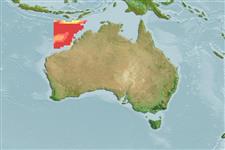分類 / Names
俗名 | 同種異名 | Catalog of Fishes(屬, 種) | ITIS | CoL | WoRMS | Cloffa
Teleostei >
Acropomatiformes (Oceanic basses) >
Malakichthyidae (Temperate ocean-basses)
Etymology: Malakichthys: Greek, malakia = softness + Greek, ichthys = fish (Ref. 45335); levis: Named for the absence of tooth-like spines on the chin ('levis' = beardless).
Environment: milieu / climate zone / depth range / distribution range
生態學
海洋 深海區的; 深度上下限 143 - 256 m (Ref. 44351). 熱帶; 11°S - 21°S, 116°E - 126°E (Ref. 57279)
Eastern Indian Ocean: northern Australia, from the North West Cape, Western Australia to Cape Arnhem, Northern Territory.
東印度洋: 澳洲北部,從西北角,澳洲西部到岬 Arnhem ,北部地區。
大小 / 重量 / 年齡
Maturity: Lm ? range ? - ? cm
Max length : 15.9 cm SL 雄魚/尚未辨別雌雄; (Ref. 44351)
簡短描述
檢索表 | 型態特徵 | 形態測量圖
臀棘: 3; 臀鰭軟條: 8. This species is distinct in having the following characters: no paired spines on chin; proximal-middle radial of first anal-fin pterygiophore is broad with cone-shaped hollow lacking lamellar septum; well developed lateral wing; A III, 8; pectoral-fin rays 14; gill rakers on lower arm 20-23; 49-53 scales on lateral line; 5-7 transverse scale rows above lateral line; body depth 26-35% SL (Ref. 76883).
Life cycle and mating behavior
成熟度 | 繁殖 | 產卵場 | 卵 | 孕卵數 | 仔魚
東印度洋: 澳洲北部,從西北角,澳洲西部到岬 Arnhem ,北部地區。
Yamanoue, Y. and K. Matsuura, 2002. Descriptions of two new acropomatid species of the genus Malakichthys (Teleostei: Perciformes) from Australia. Bull. Mar. Sci. 69(3):1139-1147. (Ref. 44351)
IUCN 瀕危狀態 (Ref. 130435: Version 2024-1)
人類使用
漁業:
工具
特別的報告
下載 XML
網路資源
Estimates based on models
Preferred temperature (Ref.
123201): 16.8 - 20.4, mean 20.4 °C (based on 8 cells).
Phylogenetic diversity index (Ref.
82804): PD
50 = 0.5078 [Uniqueness, from 0.5 = low to 2.0 = high].
Bayesian length-weight: a=0.00468 (0.00180 - 0.01218), b=3.13 (2.90 - 3.36), in cm total length, based on LWR estimates for this (Sub)family-body shape (Ref.
93245).
營養階層 (Ref.
69278): 3.7 ±0.5 se; based on size and trophs of closest relatives
Fishing Vulnerability (Ref.
59153): Low vulnerability (10 of 100).
